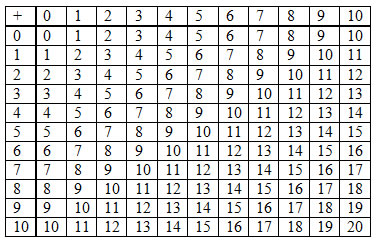
What are "basic facts"?
Basic facts are the 100 number combinations we expect children to memorize for addition and subtraction. They are the ones found in the addition table:
For example: 4+8=12 is an addition fact, and 13+12=25 is not.
13-5=8 is a subtraction fact, and 25-11=14 is not.
For addition, if both addends are between 0 and 10 (or 0-12--in some places children are learning addition facts to 12 rather than to 10), then it is a basic addition fact. For subtraction if both the subtrahend and the difference are between 0 and 10 (or 0 and 12) then it is a basic subtraction fact.
What strategies will we be looking at?
Before children really start memorizing all of these (that's a lot to memorize at once!), they figure out these number combinations using a variety of strategies. So far we have looked at direct modeling as a problem solving strategy: acting out a problem and counting all. This is the beginning strategy for understanding addition and subtraction, but children need to move to some more efficient strategies before memorizing all of the facts.
Children start by developing more efficient ways of counting to solve problems. We will be looking at the counting strategies: counting on, counting back and counting up to.
Children don't memorize the whole addition/subtraction table at once, they learn some facts sooner and other facts later. Children use the facts they know to figure out facts they don't have memorized yet. When we do this, this is what in CGI is called using deriving facts to solve, and strategies for doing this are called derived facts strategies.
At the end of chapter 3 of Childrens Mathematics, you'll find this table, which represents the learning process children go through when learning to solve number problems.

You should notice that children start solving problems by direct modeling, then they move to counting strategies which are first tied to specific problem types, and later are used for all problem types. Later still, children memorize, derive and recall number facts.
What are our sources of information?
We'll refer back to the CGI structure at some points in this unit, but our main source will be this set of Questions and Answers about teaching basic facts that was written and compiled by Edward C. Rathmell:
http://thinkingwithnumbers.com/QuestionsAnswers/index.html
Ed Rathmell and his colleagues have been studying how children learn basic facts and how best to teach basic facts to children, so this is a compilation of research on this very tricky topic.
I say very tricky because, first, teaching basic facts seems to be unavoidable--knowing the basic facts for addition, subtraction and multiplication (at least) is a key skill that is used in later math learning; no matter how much we might wish it, we can't skip teaching and learning the basic facts. Second, it's tricky because the facts seem to be very slippery: we teach and assess them in one grade and children seem to have mastered them, and after summer vacation it's all lost, and we have to reteach and relearn them the next year. We devote a long time to learning math facts, and it's spread out over most of the elementary years (grades 2-6), so it helps to be smart about how we teach.